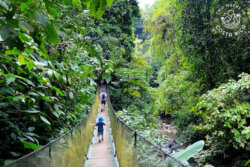Last Updated: May 20, 2024
Everyone knows about Manuel Antonio’s famed national park, but if you’re looking for something more off-the-beaten path, there’s another great option. Rainmaker Conservation Park located just outside Quepos is a private nature reserve with hiking trails, hanging bridges, and waterfalls. Below are our tips for exploring Rainmaker on a day trip from Manuel Antonio or Quepos.

History of Rainmaker Conservation Park
Before we share the details of planning your visit to Rainmaker Conservation Park, it is worth hearing about the park’s fascinating history.
Sometime around 1990, a farmer named Don Victor Fallas needed some cash so was looking to sell a portion of his land near Parrita on Costa Rica’s central Pacific coast. A Costa Rican man named Mauricio Gutierrez entered the picture. He agreed to purchase 200 hectares (500 acres) on behalf of the company the Body Shop, which wanted the farmland to grow products for use in their cosmetics.
Don Victor also owned a large amount of primary rainforest on a nearby mountain. Though he needed to sell it because of his debt, he wanted to find someone who would keep it preserved. Mauricio shared a similar vision and agreed to buy 2,000 hectares (5,000 acres) of the forest in his own name, thinking the pristine land could be valuable in a future tourism business.
Just as the paperwork was being finalized, Mauricio died tragically in an accident when he fell into a waterfall on the property while trying to save a child. With no buyer, the deal was about to fall through when Mauricio’s wife, Ann Gutierrez from the United States, stepped in.
Ann didn’t have the cash upfront but managed to get Don Victor to agree to a five-year mortgage. The only problem was that Don Victor wanted $100,000 as a down payment—and he wanted it in a week.
The story then goes back to the Body Shop. Ann contacted Gordon Roddick, co-founder of the cosmetics giant, who agreed to lend her $100,000 for the down payment. The deal went then through.
Today, the land is completely paid off and preserved.
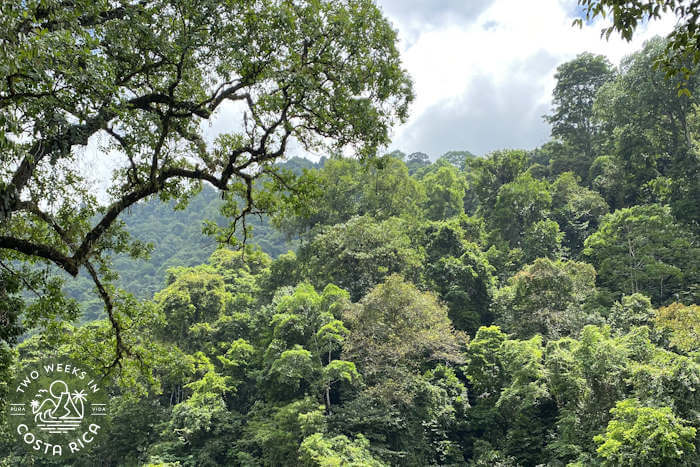
If it hadn’t been for Ann and her children Alessandra and Mick stepping in, the land probably would have been turned into a lumberyard. Apparently the bank that owned the property was in talks with a Japanese lumber company that was set to buy the land if Don Victor defaulted on his loan.
After visiting the property several times and seeing for ourselves how special it is, we can really appreciate Ann, Alessandra, and Mick’s efforts to keep Mauricio’s vision of conservation alive.
What to Expect on Your Visit to Rainmaker Conservation Park
The Trails
Rainmaker Conservation Park has a 2.5 km (1.5 mile) trail system that passes waterfalls and runs alongside a beautiful winding river.
Most of the land (about 80%) is primary rainforest, meaning that it has never been cut down.
The old growth trees and topography of the reserve create spectacular, majestic views that are hard to match. We’ve done a lot of hiking in Costa Rica, and for us, Rainmaker has some of the best views around. The way the trees tower along the mountain creates almost a wall of rich, green forest.
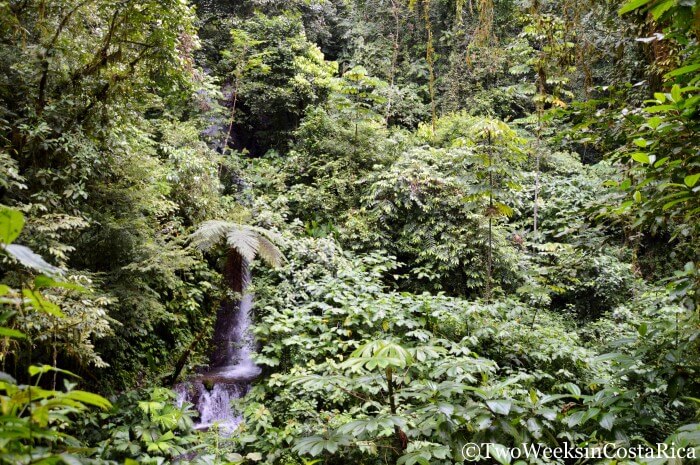
Difficulty of Hike
In terms of difficulty, the main loop is easy to moderate and suitable for most people. However, there are some areas that are steep and can be slippery if it has rained lately.
The short loop off the main trail is more difficult and climbs up the mountain to a lookout and series of suspension bridges. There are some steep steps getting up. We have done the hike with our young children several times, though, and they have been able to do it on their own starting around age 3.
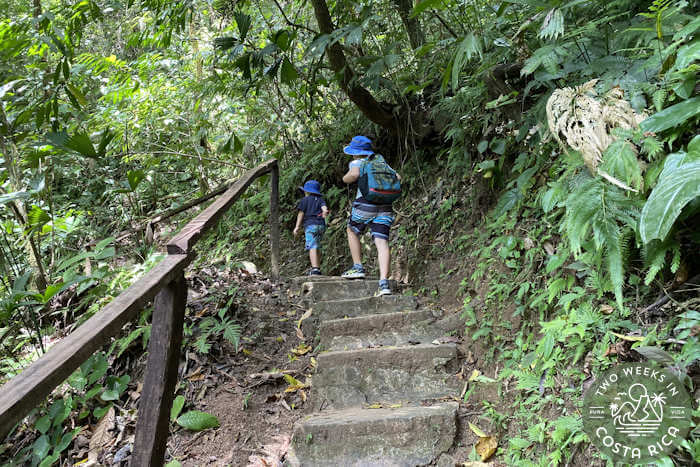
Note: If you have young children, keep a close eye on them. Although the trail has well-maintained railings throughout, there are some steep drop offs.
Hanging Bridges
The four hanging bridges are suspended high above the ground, giving you a unique vantage point from which to observe the rainforest.
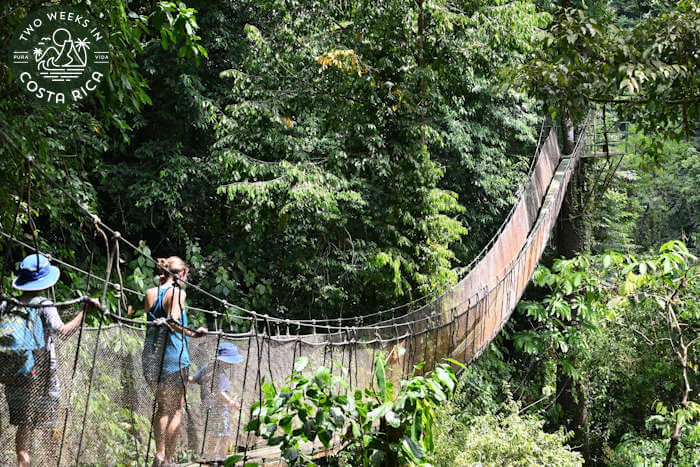
They are really fun but also narrow and a bit rickety. If you’re afraid of heights, you may want to skip them. The park is still really nice even if you only do the main loop.
Waterfalls and Swimming Holes
Right on the main loop is a nice waterfall where you can take a dip in the refreshing pool. If you do the hanging bridges, this is just after you come down the stairs from the bridges.
Rainmaker has built a concrete bench near the small waterfall for people to sit or put their belongings. You can swim over to the waterfall and take a dip or explore the gentle river.

If the main waterfall is busy, you can continue on the trail to other swimming spots. Some are a little harder to access, but still possible for most people. On our last visit, we saw another family with young kids enjoying one of the less busy pools.
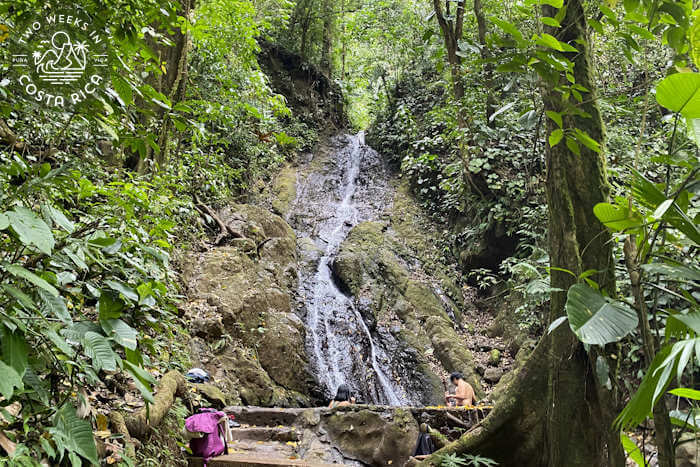
Trail Map
Just outside the reception area is a large sign with a trail map showing the hanging bridges and best swimming spots. Click here for a photo we have taken of the map.
Wildlife
Because it is a bit out of the way, Rainmaker sees a lot less foot traffic than the often busy Manuel Antonio National Park. This means that you’re more likely to have the trails all to yourself and potentially see some unique wildlife.
More than half the plants and animals that live in Costa Rica can be found at Rainmaker. On our visits, we have seen a green and black poison dart frog, whiptail lizards, and several kinds of butterflies including a glass-winged variety.

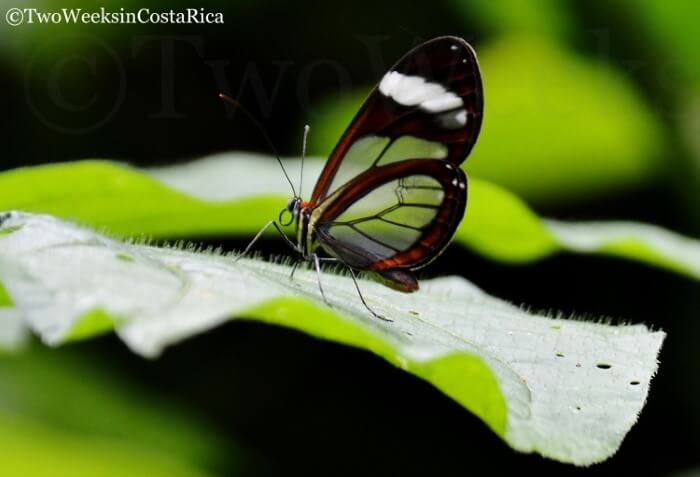
We’ve also seen lots of birds, including the Chestnut-mandibled Toucan, Blue-crowned Manakin, Black-throated Trogon, and Baird’s Trogon.
In our experience, it is harder overall to see wildlife at Rainmaker than at Manuel Antonio National Park. But you can still see some and it’s a worthwhile stop for the views and waterfalls alone.
Planning Your Visit to Rainmaker Conservation Park
Tickets
Admission is $20 per person. Free for children under 6.
You don’t need to buy tickets in advance.
Self-Guided vs. Guided Tours
You can easily just show up, pay the admission fee, and do a self-guided hike of the reserve.
Going with a knowledgeable guide can be beneficial, though, so that you learn more about the rainforest and see more wildlife. The jungle at Rainmaker is really thick so it can be hard to spot much on your own.
If you’d like to go with a guide, we would be happy to help you arrange a tour through a local company in Quepos that has knowledgeable, certified naturalist guides.
Just use the links below to request a reservation. You won’t pay until it is confirmed, and we’ll get back to you by email along the way. Booking through us costs the same and helps support our website!
Information About Guided Tours
Cost of Group Tour (8-10 people)
$65 per person plus 13% tax
Cost of Private Tour (only your family/group)
$124 per person plus 13% tax
Includes
Bilingual naturalist guide, round-trip transportation from your hotel or vacation rental home in the Manuel Antonio-Quepos area, and entrance fee.
Offered
7:50 a.m., 10:00 a.m., or 1:00 p.m.
Duration
3 hours (approximate)
What to Wear/Bring
Hiking boots or sturdy sneakers. We don’t recommend flip-flops because the terrain is uneven and you may come across biting insects.
Bathing suit and towel for swimming in the natural pools (it’s best to wear your bathing suit under your clothes)
Change of clothes
Plenty of water
Insect repellent, especially if you’re visiting during the rainy season (May through November)
Hours
Rainmaker is open daily from 7:30 a.m. to 6:00 p.m.
Avoiding Rain
Rainmaker is so named for a reason. The property sits near the mountains where rain is more frequent. If you’re visiting during the rainier months (May through November), try to arrive in the morning to lessen the likelihood of rain during your visit.
Lunch
Lunch can be purchased at the small restaurant onsite for $7 per person. It’s a typical Costa Rican casado. This service is available from 11 a.m. to 1 p.m.
Directions to Rainmaker Conservation Park
Rainmaker is located about 30 minutes from Manuel Antonio/Quepos. It’s about 15-20 minutes off the Costanera highway, Route 34, in the village of San Rafael Norte near the town of Parrita. There is a sign for Rainmaker at the turnoff on Route 34.
The road leading to the reserve is mostly rough dirt, with some paved sections. Four-wheel drive is not required. You’ll pass through some towns along the way to the reserve.
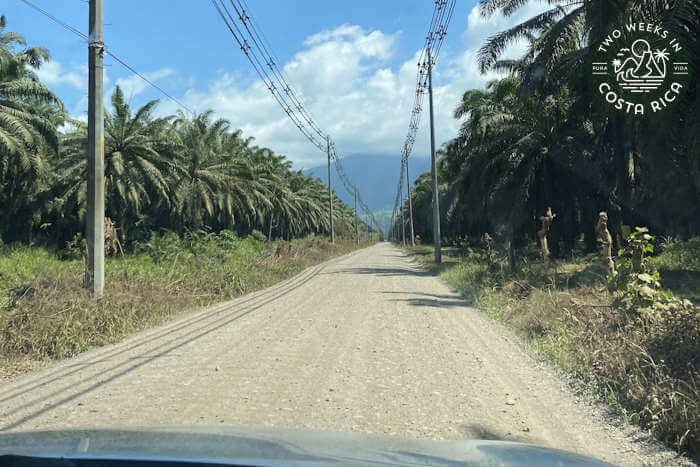
Because Rainmaker is quite far off the main road (about 7 km/4.3 miles), we don’t recommend taking the bus and walking the rest of the way from the highway.
Conclusion
Rainmaker Conservation Park is a great place to spend a few hours if you’re visiting the Manuel Antonio/Quepos area. Not only will you take in some beautiful scenery and see interesting plants and animals, but you’ll get to experience a special part of Costa Rica that was almost lost.
Last Updated: May 20, 2024
Have you visited Rainmaker? What did you think?
Looking for more information to plan your trip to Costa Rica? Check out these posts:
7 Off-the-Beaten-Path Things to Do Near Manuel Antonio: Check out these ideas for more lesser known activities in the Manuel Antonio area.
Manuel Antonio Restaurant Guide: With over 75 restaurants, it can be hard to sort through the options. Read our updated guide to get the best meals in town.
Hacienda Baru Wildlife Refuge: Another great nature reserve is Hacienda Baru, about 45 minutes south of Manuel Antonio in Dominical. This private reserve never gets too busy and has lots of wildlife and excellent birding.

